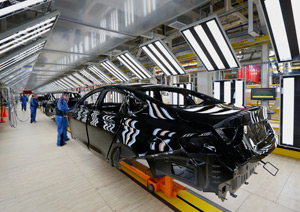Factory Production Barely Rises in March

Factory output barely climbed in March, marked by a rebound in auto making as other industries retreated, indicating a strong dollar and cheap oil are hurting American manufacturing.
The 0.1% gain in manufacturing was the first advance in four months and followed a 0.2% February decrease, a Federal Reserve report showed April 15. That matched the median forecast in a Bloomberg News survey of 24 economists. Total industrial production declined more than projected as utility use dropped by the most in nine years.
Manufacturers are taking a hit as a stronger dollar and soft global markets depress exports, and oil companies pare operations amid a plunge in fuel prices. Auto sales remain a bright spot as consumers benefit from an improving job market and low interest rates, a sign assembly lines will keep running.
“Manufacturing looks soft for sure, and it’s due to headwinds from the dollar,” said Guy Berger, a U.S. economist at RBS Securities Inc. in Stamford, Connecticut, who correctly projected the drop in industrial production. “Maybe growth is still possible in manufacturing, but it’s gotten harder to squeeze out. The dollar is definitely a big dampener.”
Other reports April 15 showed manufacturing in the New York region unexpectedly contracted this month as orders slumped and builder confidence firmed.
Total industrial production declined 0.6%, the biggest drop since August 2012. It was projected to fall 0.3%, according to the Bloomberg survey of 83 economists. Estimates ranged from a drop of 0.9% to a 0.6% gain. Output in February rose 0.1%, the same as previously reported.
Manufacturing production, which makes up about 75% of the total, slumped at a 1.2% annual rate in the first three months of the year, the biggest drop since the second quarter of 2009, just as the recession was ending.
Utility output fell 5.9%, the biggest decrease since January 2006, after jumping 5.7% the previous month.
More seasonable weather in March followed plummeting temperatures, limiting demand for utilities.
Mining production, which includes oil drilling, decreased 0.7% in March, the third consecutive decline. Oil and gas well drilling plunged at almost a 70% annualized rate last quarter, according to the figures.
The Fed report also showed capacity utilization, which measures the amount of a plant that is in use, dropped to 78.4% from 79% in February.
The output of motor vehicles and parts increased 3.2% after dropping 3.6% a month earlier. Excluding autos and parts, factory production declined 0.1% in March after being little changed a month earlier.
Vehicle demand remains a mainstay for factories. Purchases of cars and light trucks rose to a 17.1 million annualized rate in March from 16.2 million a month earlier, according to Ward’s Automotive Group. Korean automakers posted unexpected increases while sales fell at Ford Motor Co. and General Motors Co.
“Growth in the manufacturing sector is steady, but it’s being impacted by a variety of factors, both positive and negative,” Emily Kolinski Morris, Ford’s chief economist, said on an April 1 sales call. “We expect a firming labor market and still low fuel prices and interest rates to support renewed momentum in economic activity as spring takes hold.”
Machinery production was little changed last month, and construction materials dropped 0.9%, the report showed.
Labor-market progress and cheap gasoline are helping to underpin household spending, which accounts for about 70% of the economy. While payrolls rose by a less-than-forecast 126,000 workers in March, the gain followed a 12-month streak of increases of 200,000 or more.
Sales at retailers rose less than forecast in March after being depressed by harsh winter weather in February, Commerce Department data showed April 14. Demand climbed in nine of 13 major retail categories.
Some recent reports indicate struggling overseas economies, the surge in the dollar and cutbacks among oil producers are weighing on manufacturing. The Institute for Supply Management’s factory index showed factories expanded in March at the slowest pace since May 2013.
Oil prices have slumped more than 50% since the end of June, and the greenback has climbed almost 25% since then.

